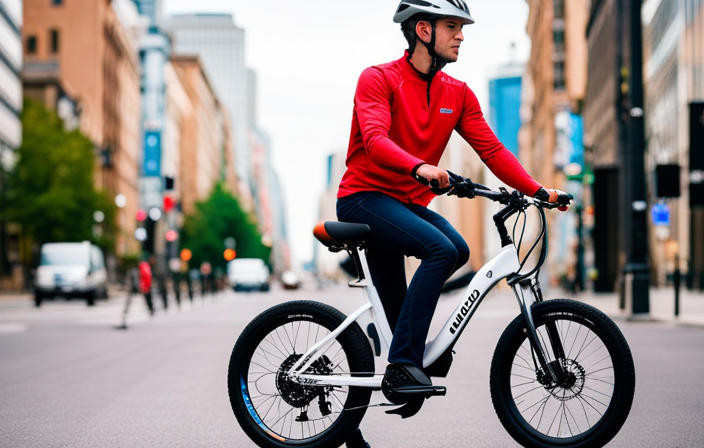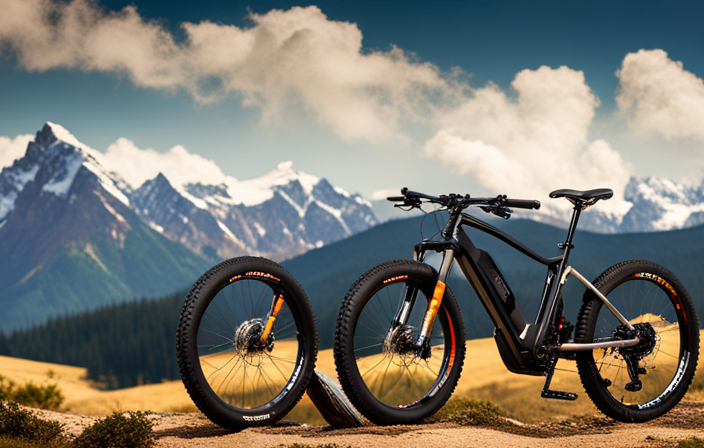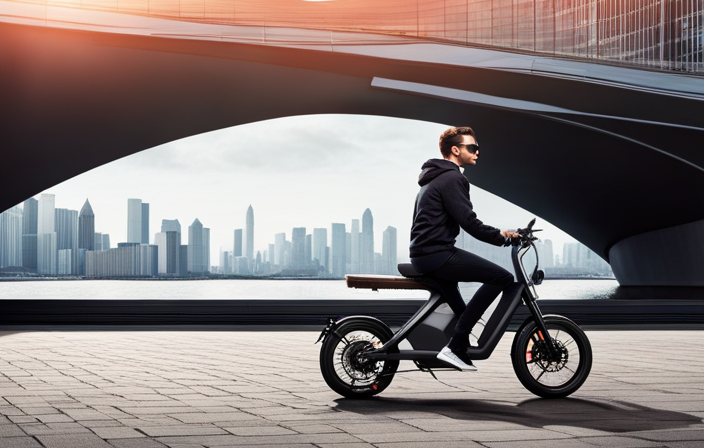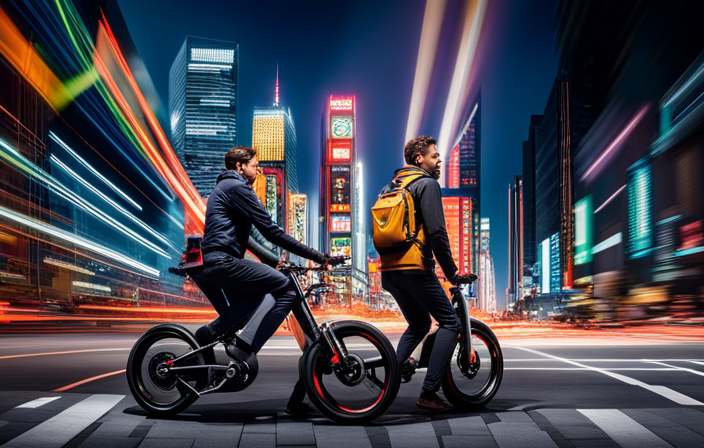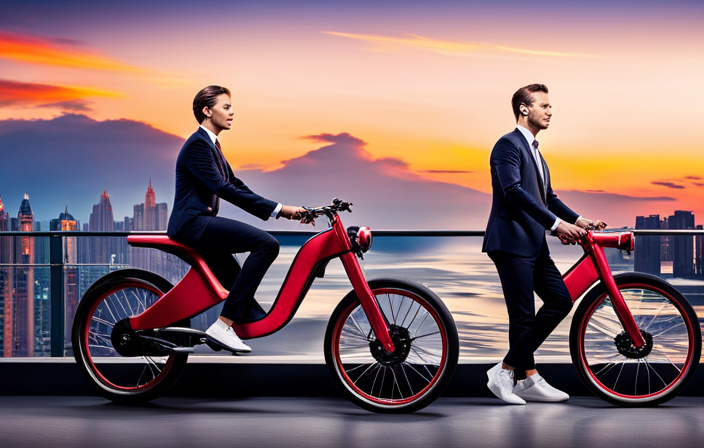Are you ready to embark on electrifying adventures with your new electric bike?
Before you hit the road, it’s crucial to master the proper technique of mounting your bike. In this article, I will guide you step by step on how to mount an electric bike with precision and finesse.
From understanding the bike’s weight and balance to using your core muscles for stability, I’ll provide you with the essential tips and tricks to ensure a smooth and confident start to your ride.
So, let’s dive in and elevate your biking experience to new heights!
Key Takeaways
- Position yourself and the bike correctly by aligning your body with the bike and gripping the handlebars firmly.
- Adjust the saddle height for comfort and efficiency by standing next to the bike, placing your heel on the pedal in its lowest position, and setting the saddle angle for support and comfort.
- Place your feet on the pedals by aligning them with the pedals, placing the balls of your feet on the center of the pedals, and keeping your feet parallel to the ground.
- Use the proper technique to push off by positioning your feet correctly on the pedals, using your dominant foot to push off the ground, maintaining a balanced and stable posture, and generating momentum to propel forward while keeping your body weight centered.
Understand the Bike’s Weight and Balance
Before you’re able to properly mount an electric bike, it’s important to understand the bike’s weight and balance. The bike’s weight distribution plays a crucial role in determining its stability and maneuverability.
To comprehend this, it is essential to grasp the concept of the bike’s center of gravity. The center of gravity refers to the point where the bike’s weight is evenly distributed. When mounting the bike, it’s crucial to position yourself in a way that maintains this balance.
Make sure your body weight is centered and evenly distributed on the bike. This will allow for better control and prevent any sudden shifts in weight that could lead to instability.
With a solid understanding of the bike’s weight distribution and center of gravity, you can now proceed to properly position yourself and the bike correctly for a safe and comfortable ride.
Position Yourself and the Bike Correctly
To ensure a smooth mount, position yourself in the right spot and align your body with the bicycle. This will help you maintain balance and control during the mounting process. Proper hand placement is crucial for stability, so make sure to grip the handlebars firmly, but not too tightly.
Finding the right center of gravity is also important. Keep your weight evenly distributed between both feet and avoid leaning too far forward or backward. This will help you maintain control and prevent the bike from tipping over.
Remember to adjust the saddle height as well to ensure a comfortable and efficient riding position. By following these steps, you can properly position yourself and the bike for a safe and enjoyable ride.
Now, let’s move on to adjusting the saddle height.
Adjust the Saddle Height
Make sure you adjust the saddle height to find a comfortable riding position. To set the saddle height, start by standing next to the bike and facing forward. Place one heel on the pedal in its lowest position. The saddle height is correct when your leg is fully extended with a slight bend at the knee.
Next, set the saddle angle to ensure proper support and comfort. Choose a saddle that suits your riding style and body shape. Consider factors such as width, padding, and cutouts.
Once the saddle is adjusted to your liking, you can now place your feet on the pedals and prepare to ride. It is important to ensure that your feet are properly positioned and ready to engage with the pedals for a smooth and efficient ride.
Place Your Feet on the Pedals
Once you’ve adjusted the saddle height, you can simply place your feet on the pedals and get ready to ride. Proper pedal placement is crucial to ensure a comfortable and efficient ride. Here are some key points to keep in mind:
- Align your feet with the pedals to ensure proper positioning.
- Place the balls of your feet on the center of the pedals for optimal power transfer.
- Keep your feet parallel to the ground to maintain stability.
- Maintain pedal pressure by applying downward force evenly through each stroke.
- Avoid gripping the pedals too tightly, as it can lead to muscle fatigue.
By following these guidelines, you’ll be able to maintain control over your electric bike and maximize your performance.
Now, let’s explore the proper technique to push off and start your ride smoothly.
Use the Proper Technique to Push Off
Before pushing off, it’s important to use the proper technique. To achieve balance and stability, start by positioning your feet on the pedals in the correct manner. Make sure your feet are centered on the pedals, with the balls of your feet resting on them. This will provide optimal power transfer and control.
Once your feet are in the right position, use your dominant foot to push off the ground. Apply downward force on the pedal while simultaneously pushing off with your foot. This will generate momentum and propel you forward. As you push off, keep your body weight centered and maintain a stable posture. This will ensure that you have a balanced and stable position to start your ride.
Transitioning into the next section, maintaining this balanced and stable position is crucial for a safe and enjoyable electric bike experience.
Maintain a Balanced and Stable Position
To achieve a safe and enjoyable ride, it is crucial to maintain a balanced and stable position on your e-bike. This starts with maintaining a stable posture throughout the entire ride.
Keep your back straight and relaxed, and distribute your weight evenly between the handlebars and the saddle. To improve balance techniques, practice keeping your core engaged and your knees slightly bent. This will help you maintain stability and absorb any bumps or vibrations while riding.
Additionally, focus on keeping your eyes ahead and looking in the direction you want to go. This will help you anticipate and react to any obstacles or changes in the road.
By maintaining a balanced and stable position, you can ride with confidence and control.
In the next section, we will discuss how to practice proper body alignment to further enhance your riding experience.
Practice Proper Body Alignment
Practice maintaining a stable and balanced position on your e-bike by focusing on proper body alignment. Body posture plays a crucial role in ensuring stability and control while riding.
Start by keeping your back straight and relaxed, with your shoulders squared and slightly rolled back. This will help distribute your weight evenly and prevent strain on your neck and back.
Additionally, bend your elbows slightly and keep them relaxed to absorb any shocks or vibrations. As you ride, engage your core muscles to maintain stability and support your upper body.
By using your core muscles, you will be able to maintain a steady position and react quickly to any changes in terrain or speed.
Transitioning into the next section, remember that using your core muscles for stability is essential for a safe and enjoyable e-bike experience.
Use Your Core Muscles for Stability
Ensure that you engage your core muscles to maintain stability and support your upper body while riding your e-bike. Riding an electric bike requires proper body alignment and a strong core for stability.
To achieve this, it is crucial to engage your abdominal muscles throughout the ride. By using your core muscles, you improve your balance and reduce the strain on your back and shoulders. One effective way to strengthen your core muscles is through core strength training exercises such as planks and bicycle crunches. These exercises target the muscles in your abdomen, lower back, and hips, helping you maintain stability and control while riding.
By incorporating core workouts into your routine, you can enhance your overall riding experience and minimize the risk of injuries.
Now, let’s transition into the next section and discuss the importance of starting with slow and controlled movements.
Start with Slow and Controlled Movements
To maintain stability while mounting an electric bike, it is crucial to engage your core muscles. This not only helps to keep your body balanced but also ensures a controlled and steady movement.
Now, let’s focus on the importance of starting with slow and controlled movements. By doing so, you allow yourself to get accustomed to the weight and balance of the bike.
Here are some tips to maintain balance and stability during the mounting process:
- Keep your feet shoulder-width apart.
- Place one foot on the ground and the other on the pedal.
- Maintain a firm grip on the handlebars.
- Use your core muscles to lift yourself onto the bike.
Remember, starting with slow and controlled movements is key to building a strong foundation for mounting an electric bike. By practicing these techniques, you will gradually gain confidence and improve your overall riding experience.
Keep Practicing and Building Confidence
Keep working on your skills and gaining confidence to improve your overall experience riding an electric bike. Building confidence and skills is essential for becoming a proficient electric bike rider. The more you practice, the more comfortable you will become with your bike and its capabilities. Start by riding in controlled environments, such as empty parking lots or quiet streets, to build your confidence before venturing into busier areas. Gradually increase your speed and try different terrains to challenge yourself and improve your skills. Don’t be afraid to push your limits, but always prioritize safety. As you gain more experience, you’ll develop a better understanding of how your bike handles and be able to navigate various situations with ease. Remember, building confidence and skills takes time, so keep practicing and enjoy the journey.
| Emotion | Explanation |
|---|---|
| Excitement | As you build confidence and skills, you’ll feel a sense of excitement and accomplishment, motivating you to continue improving. |
| Empowerment | The more proficient you become, the more empowered you’ll feel to tackle new challenges and explore new places on your electric bike. |
| Freedom | Building confidence and skills allows you to experience the freedom of riding an electric bike, giving you the ability to effortlessly travel longer distances. |
| Joy | Riding an electric bike can bring immense joy, and as you build confidence and skills, that joy will only amplify. |
| Confidence | Building confidence on an electric bike not only improves your riding experience but also boosts your overall confidence in other areas of life. |
Frequently Asked Questions
What should I do if the electric bike feels too heavy for me to mount?
If the electric bike feels too heavy for me to mount, I can adapt my mounting techniques by placing one foot on a raised surface or using a step stool. Additionally, I can use assistive devices like a ramp or a bike lift to make mounting easier.
Are there any specific tips for mounting the bike if I have a physical disability or limited mobility?
There are adaptive equipment options available, such as adjustable seat heights or step-through frames, that can assist individuals with physical disabilities or limited mobility in mounting an electric bike. Supportive techniques include using a mounting aid or having someone provide assistance.
How can I ensure that the saddle height is adjusted correctly for me?
To ensure correct saddle height adjustment on an electric bike, start by sitting on the saddle with feet flat on the ground. Adjust the saddle angle and handlebar height to achieve a comfortable riding position.
What should I do if I’m having trouble finding a stable position on the bike?
If I’m having trouble finding a stable position on the bike, I should start by ensuring that I have the right bike size. Then, I can adjust the handlebars for comfort, making sure they are at the correct height and angle.
Are there any exercises or stretches I can do to improve my body alignment and stability while mounting the electric bike?
To improve body alignment and stability while mounting an electric bike, incorporating exercises and stretches can be highly beneficial. These exercises focus on core strength, balance, and flexibility, ensuring a stable and aligned position on the bike.
Conclusion
In conclusion, properly mounting an electric bike is essential for a safe and enjoyable ride. By understanding the bike’s weight and balance, positioning yourself correctly, and adjusting the saddle height, you can ensure a comfortable riding experience.
Additionally, using the proper technique to push off, practicing proper body alignment, and engaging your core muscles for stability are all key factors in mounting an electric bike.
Remember, practice makes perfect, so keep practicing and building confidence.
Did you know that electric bikes have been gaining popularity worldwide, with sales increasing by 25% each year? So get out there and start enjoying the benefits of this eco-friendly mode of transportation.
